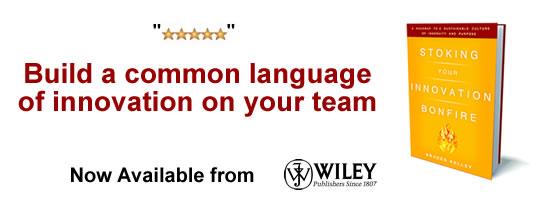We are in need of a common language for innovation
 Any innovation common language needs working upon. It firstly needs recognition it is in our best interests to find a common point. It needs to be relevant to each of us, it must be current, appropriate, accurate and highly visible throughout the entire organization. It also needs to be allowed to grow and flourish, to evolve and become the lingua franca of all our innovation work. It needs building and constructing in conscious ways and design.
Any innovation common language needs working upon. It firstly needs recognition it is in our best interests to find a common point. It needs to be relevant to each of us, it must be current, appropriate, accurate and highly visible throughout the entire organization. It also needs to be allowed to grow and flourish, to evolve and become the lingua franca of all our innovation work. It needs building and constructing in conscious ways and design.
Let’s step back just for one minute, these ‘sentiments’ are fine, yet we actually do, seriously lack a common language for innovation and we should find the ways and the means to change this. It holds innovation back significantly. It can’t continue in a world of greater networking and collaboration.
Languages unites us or keeps dividing us
Language can have the power to unite us or potentially divide us. Developing a language to unite us in our innovation efforts goes some way to reduce disagreements and egos, to qualify individual interpretation or bias, often a key inhibitor that can block a team’s success. It lays in a common foundation. It builds confidence and understanding.
Once we have a common language, we can set about building and creating a more robust innovation management system. One that builds on this framework so it can relate to the relevant context, conditions, and environment for innovation, to offer within this building block, the common identity.
These identifiers can build into better understanding how to structure governance, process, and functional structures, to build a culture that is responsive as ‘they’ can identify a need for a common cause of understanding. It is in this central innovation language that becomes our clear unifying context, the enabler, and sense of personal identity with the purpose of what we are wishing to achieve.
In any common language, we need to master the understanding, the nuances and how it all fits together. We need to exploit it and extract what it can offer to enhance all the work we do in innovation. We need to appreciate always its terms, its definitions (and limitations) and the related performance values that can help to improve our performance and in our achievements of working increasingly with others. A common understanding of our meaning to ‘innovate’ becomes an imperative.
Today we all having a different meaning and interpretations within our innovation understanding.
Each organization has specifics in meaning that can often end up in results that break down and so deliver results totally different from their original intent. As we grow out our collaborations into ecosystems the need for a common language becomes even more vital. For example:
- Often misunderstanding occurs, even though we initially thought we had communicated well but those that receive this often apply different interpretations that confirm their personal views,
- There is always this risk that others often apply subtle nuances and variations built on their experiences or understanding on how ‘something works’, and it is within these different readings we can suffer costly errors, extensive delays and wrong end results in the final product or service delivery.
- We suffer significant inefficiencies because we don’t pay enough attention to ensuring the correct meaning is well understood, we simply believe our way of thinking is the only way it is conveyed to be understood, and as we all know, this is often far from the reality. Context and Communications are kings in my opinion.
- We need to seek explicit language and context to allow innovation to do its final job, of delivering a valuable new contribution that builds on the existing and meets new market and customers’ needs or the jobs-to-be-done.
Innovation becomes highly constrained if we fail to find that common language, that common purpose, the understanding of the right context and ended up providing something that was not as good as it could have been, or we simply veered completely off track, on the original insight. It somehow got lost in translation, in applying individual meaning. Translation is one of those keys that can unlock so much within innovation but often it just simply goes the other way and gets “lost in translationâ€
To apply a common language, we need to invest in its practice
The more we practice and move towards a common understanding of innovation, we are moving towards clarifying and reconciling, as best we can, within the constraints of what common language or context offers. We give innovation a greater chance to succeed. A common language enables greater transparency, clarity in accountability through its definitions; we achieve greater collaborative dialogues and meet more concurrence than without this move towards a common understanding.
So much of innovation is piecing together many fragmented pieces, strands of knowledge that can be unstructured can be very ambiguous, yet requires sound judgment. Innovation builds on shared experience and the quality of its interaction points. The more we learn to collaborate, the more we begin to share experiences, the more we achieve a growing common language. We need to bring together increasingly the parts that growing specialization, our limited grasp of all the complexities that can influence a decision. We need to constantly reconcile incoming information with our own language of understanding, so we need to strive towards improving the common parts surely?
I think as we build a common language we need a certain learning rhythm.
This is where absorptive capacity can come in, as it offers a structured way of building our knowledge understanding and fits within this. Absorptive capacity has the different steps of acquiring, assimilating, transforming and exploiting but these need a clear sequence, structure, and commonality to their approach, to gain the lasting benefit.
A common language of innovation working to a common end cause also allows for a knowledge learning repository to be built up, so all can potentially prosper as their starting point to innovate, as they learn from past experiences and insights. Innovation is something we all can do, not just a selected few but it is sharing our knowledge can encourage others to find the time and then invest in all of what it can mean to them; liberating them to explore alternatives and exploit their experiences by applying something ‘gained’ as something
Innovation is something we all can do, not just a selected few but it is sharing our knowledge can encourage others to find the time and then invest in all of what it can mean to them; liberating them to explore alternatives and exploit their experiences by applying something ‘gained’ as something enhancing.
A bedrock for building and sustaining innovation is a common intent, language, and context
Forming a common language should be the bedrock for how we set about innovation. It cannot be silo driven or developed to fit one individual team, unless you want stilted results with incremental innovation being most likely as the best you can achieve most of the time, within this ‘constraint’, as we increasingly need to reach out and learn to collaborate
How we go about our communications, what and who you can connect with and your level of innovation engagement, do matter significantly. It is the ability to find the common identity, a real unifying sense of purpose that sends positive signals to all involved and those interested parties, often external to your ‘inner’ innovation process, to engage fully.
A common language can change much within innovation. Can we find the investment time to build this into the work we need to do? We should. It is in all of our future collaborating interests.
Wait! Before you go…
Choose how you want the latest innovation content delivered to you:
- Daily — RSS Feed — Email — Twitter — Facebook — Linkedin Today
- Weekly — Email Newsletter — Free Magazine — Linkedin Group
 Paul Hobcraft runs Agility Innovation, an advisory business that stimulates sound innovation practice, researches topics that relate to innovation for the future, as well as aligning innovation to organizations core capabilities. Follow @paul4innovating
Paul Hobcraft runs Agility Innovation, an advisory business that stimulates sound innovation practice, researches topics that relate to innovation for the future, as well as aligning innovation to organizations core capabilities. Follow @paul4innovating
NEVER MISS ANOTHER NEWSLETTER!
LATEST BLOGS
How Brexit Has Affected UK E-commerce Businesses
Photo by Zyro on Unsplash The popularity of online shopping was already growing at an impressive rate – and…
Read MoreOvercoming range anxiety: three tips for EV owners
Photo by Jenny Ueberberg on Unsplash In the last few years, electric vehicles (EVs) have become more and more…
Read More


